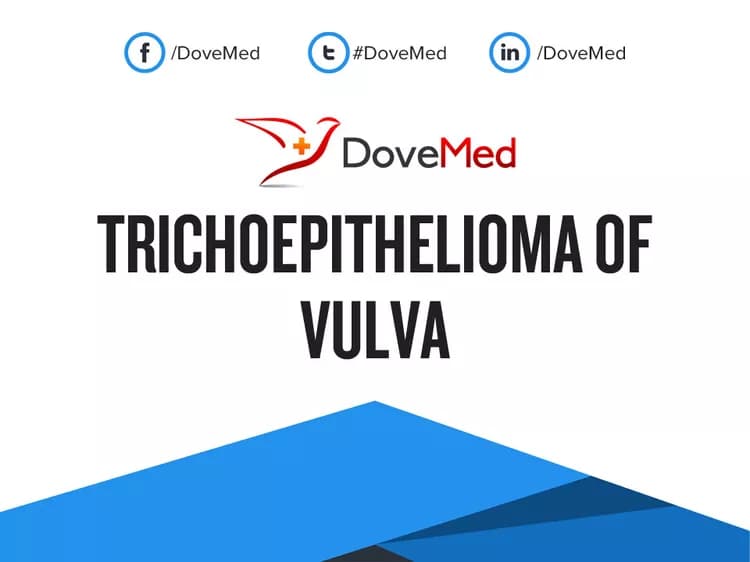What are the other Names for this Condition? (Also known as/Synonyms)
- Vulvar Trichoepithelioma
What is Trichoepithelioma of Vulva? (Definition/Background Information)
- Trichoepithelioma of Vulva is a slow-growing, benign tumor of the hair follicles that occurs on the vulva (external part of the vagina)
- It is an irregularly occurring tumor that presents as a painless nodule. Normally, the tumor is seen on the head and neck region. The vulva is an uncommon location
- Vulvar Trichoepithelioma can occur in both girls and young women. Currently, the causes and risk factors for Trichoepithelioma of Vulva are unknown
- In a majority of cases, treatment is not needed, unless it causes troublesome symptoms or cosmetic concerns in the individual
- Removing the tumor by a simple surgical excision is considered curative. The prognosis for Trichoepithelioma of Vulva is excellent with appropriate treatment
Who gets Trichoepithelioma of Vulva? (Age and Sex Distribution)
- Trichoepithelioma of Vulva can occur in a female of any age, but it is most commonly observed during pubertal stage, adolescence, and early adulthood
- Individuals of all racial and ethnic backgrounds could be affected. There has been no geographical localization of Trichoepithelioma of Vulva reported
What are the Risk Factors for Trichoepithelioma of Vulva? (Predisposing Factors)
- Currently, there are no risk factors identified for Trichoepithelioma of Vulva
It is important to note that having a risk factor does not mean that one will get the condition. A risk factor increases one's chances of getting a condition compared to an individual without the risk factors. Some risk factors are more important than others.
Also, not having a risk factor does not mean that an individual will not get the condition. It is always important to discuss the effect of risk factors with your healthcare provider.
What are the Causes of Trichoepithelioma of Vulva? (Etiology)
The cause of formation of Trichoepithelioma of Vulva is currently unknown.
- Research is being undertaken to identify the relevant causal factors
- The condition is non-infectious; it does not spread sexually (or by direct physical contact) from one individual to another
What are the Signs and Symptoms of Trichoepithelioma of Vulva?
The signs and symptoms of Trichoepithelioma of Vulva include:
- It often occurs as a single, elevated nodule on the skin; it is a slow-growing tumor
- The size of the nodule can range from a few millimeters to a centimeter. However, these nodules can grow to larger sizes as well
- The skin may have a reddish discoloration over the nodules
- The nodule is typically painless and does not itch. They are mostly well-demarcated and firm to the touch
- These nodules rarely occur in the vulva; Most often, the usual sites include the head and neck region, the chest, and the upper back
How is Trichoepithelioma of Vulva Diagnosed?
A diagnosis of Trichoepithelioma of Vulva may involve the following:
- A thorough medical history and physical examination
- Dermoscopy: It is a diagnostic tool used by a dermatologist to examine the skin using a special magnified lens
- Wood’s lamp examination: In this procedure, the healthcare provider observes the skin using ultraviolet light. It is performed to inspect a change in skin pigmentation
- Skin biopsy: A skin biopsy is performed and sent to a laboratory for a pathological examination. The pathologist examines the biopsy under a microscope. After putting together clinical findings, special studies on tissues (if needed) and with microscope findings, the pathologist arrives at a definitive diagnosis
- Differential diagnosis of other tumors, such as basal cell carcinoma, should be ruled out; hence, a biopsy is an important diagnostic tool
Many clinical conditions may have similar signs and symptoms. Your healthcare provider may perform additional tests to rule out other clinical conditions to arrive at a definitive diagnosis.
What are the possible Complications of Trichoepithelioma of Vulva?
Vulvar Trichoepithelioma is a rare tumor that is not known to cause any significant complications.
- Some individuals may experience discomfort and pain during sex
- There may be a difficulty in walking or sitting in some women
- Affected individuals may be under emotional and psychological stress due to the tumor
- Some tumors may recur, if incompletely removed
How is Trichoepithelioma of Vulva Treated?
The treatment of Trichoepithelioma of Vulva may include the following:
- In most cases, removal of the tumor is not required, unless it causes bothersome signs and symptoms like cosmetic issues
- The treatment is a complete surgical excision of the tumor, which results in a cure
- Usually, the nodule does not recur once it is completely removed. An inadequate removal may result in its recurrence
- Vaporization (burning-off) of the nodule can be completed using a CO2 laser
How can Trichoepithelioma of Vulva be Prevented?
Currently, there are no known methods to prevent Trichoepithelioma of Vulva.
What is the Prognosis of Trichoepithelioma of Vulva? (Outcomes/Resolutions)
The prognosis for Trichoepithelioma of Vulva is excellent with appropriate treatment since it is a benign tumor.
Additional and Relevant Useful Information for Trichoepithelioma of Vulva:
- There is no evidence to verify that oily foods and chocolate-based products have an effect on tumor formation
- Cleaning the skin roughly with strong chemicals or soaps may aggravate the skin disorder. Strong soaps and chemicals should be avoided, as they could potentially worsen the condition
- The presence of dirt on the body is not a causative factor for the condition. However, it is helpful to be clean and hygienic, which may prevent the condition from worsening
Related Articles
Test Your Knowledge
Asked by users
Related Centers
Related Specialties
Related Physicians
Related Procedures
Related Resources
Join DoveHubs
and connect with fellow professionals



0 Comments
Please log in to post a comment.